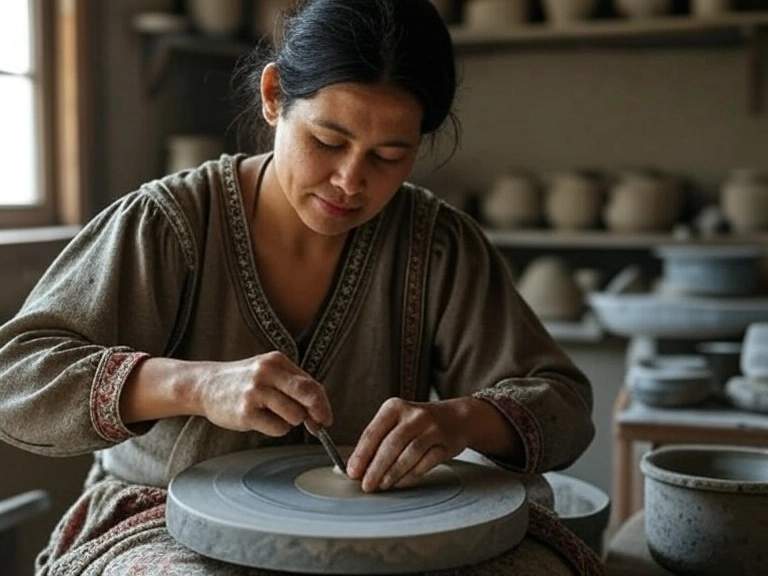Cultural traditions are part of daily life – whether people realize it or not. They shape what we eat, how we celebrate, and the values we pass on. Some traditions are loud and public, like festivals or national holidays. Others are quiet, like family recipes or simple greetings passed from one generation to the next.
People grow up with different customs depending on where they live and who raises them. A morning ritual in one country may feel unusual in another. That’s what makes cultural traditions so rich – they reflect the story of a place, its people, and its past.
Across the world, traditions help define identity. They bring people together, especially in times of change. In families, they offer structure and continuity. In communities, they build a sense of unity. They’re not just about history – they’re about meaning.
What Is a Cultural Tradition?
A cultural tradition is a shared practice, belief, or custom that is passed down from one generation to the next within a specific group, community, or society. These traditions shape how people celebrate, express themselves, interact with others, and understand the world around them.
Cultural traditions can include holidays, festivals, clothing, rituals, food, music, language, religious ceremonies, and many other forms of expression. They often reflect the values, history, and identity of a culture.
What makes a cultural tradition important is that it helps people feel connected – to their ancestors, their community, and their cultural roots. Even when the world changes, traditions help preserve the meaning and continuity of a group’s way of life.
Each tradition is unique, yet they all serve a similar purpose: to honor the past, strengthen social bonds, and keep cultural heritage alive.
60 Cultural Traditions Examples & Their Meanings
1. Tibetan Prayer Flags
Colorful flags printed with prayers and mantras are hung across mountains, rooftops, and temples. The wind is believed to carry blessings and goodwill. They represent compassion, peace, and the Buddhist connection to nature.
2. Mexican Day of the Dead (Día de los Muertos)
This tradition honors deceased loved ones with altars, candles, sugar skulls, marigolds, and favorite foods. Rather than mourning, families celebrate the lives of the dead, believing their spirits return to visit. It’s a powerful example of how culture shapes the way people relate to death and memory.
3. Indian Diwali Festival
Diwali, the Festival of Lights, celebrates the triumph of light over darkness and good over evil. Homes are decorated with oil lamps (diyas), sweets are shared, and families light fireworks. It’s one of India’s most important festivals and is observed by Hindus, Sikhs, Jains, and some Buddhists.
4. Scottish Highland Games
A vibrant tradition combining sport and culture, the Highland Games feature caber tossing, tug-of-war, bagpipes, Highland dancing, and kilts. These gatherings celebrate Scottish heritage, especially in rural communities, and are also popular among the global Scottish diaspora.
5. Chinese New Year
Also known as Lunar New Year, this celebration includes red decorations, lion and dragon dances, family banquets, and honoring ancestors. It’s a time for letting go of the old and welcoming new beginnings. Each year is associated with a different animal from the Chinese zodiac.
6. Ethiopian Coffee Ceremony
In Ethiopia, coffee is more than a drink — it’s a ritual. Beans are roasted, ground, brewed, and served in three rounds: abol, tona, and baraka. This ceremony is central to hospitality and often involves conversation, storytelling, and bonding with guests.
7. Maasai Coming-of-Age Ceremonies
Among the Maasai of Kenya and Tanzania, boys undergo a series of rites to mark their transition into adulthood, including circumcision and warrior training. Traditional dress, dance, and oral teachings are passed down through the elders during these sacred moments.
8. American Thanksgiving
Celebrated in the United States on the fourth Thursday of November, Thanksgiving centers on a shared meal—typically turkey, stuffing, and pie. It’s a day for giving thanks and gathering with family. The tradition traces back to early colonial harvest festivals.
9. Polish Wigilia (Christmas Eve Supper)
On December 24, Polish families share a meatless dinner with 12 symbolic dishes. An extra seat is left for an unexpected guest, and a wafer is broken and shared with wishes of peace. Wigilia is a heartfelt tradition of hospitality and faith.
10. Thai Water Festival (Songkran)
Marking the Thai New Year in mid-April, Songkran is famous for joyful public water fights. But it also includes visiting temples, giving alms to monks, and washing the hands of elders to seek blessings. Water symbolizes purification and a fresh start.
11. Russian Orthodox Easter Eggs
In Russia, Easter is celebrated by painting eggs, often in red to symbolize the blood of Christ. Some families create intricate designs using wax-resist techniques. The egg, a symbol of new life, is blessed in church and shared among loved ones.
12. Balinese Temple Offerings (Canang Sari)
Balinese Hindus prepare daily offerings of flowers, food, and incense in small palm-leaf baskets. These are placed at temples, homes, and shops as a sign of gratitude to the gods. It’s a quiet yet vital part of life in Bali, combining beauty, faith, and discipline.
13. German Oktoberfest
Originally a royal wedding celebration in 1810, Oktoberfest is now a global symbol of German culture. Held in Munich, it features traditional clothing (lederhosen and dirndls), folk music, hearty food, and beer. It’s a joyful celebration of Bavarian heritage.
14. Korean Chuseok (Harvest Festival)
Chuseok is Korea’s version of Thanksgiving, where families honor ancestors through rituals, visit hometowns, and prepare traditional foods like songpyeon (rice cakes). It’s a time to express gratitude for the harvest and reconnect with family.
15. Native American Powwow
A powwow is a gathering that brings together Native American tribes to celebrate culture through dance, drumming, regalia, and storytelling. It’s both sacred and social, fostering community pride and preserving Indigenous traditions.
16. Turkish Oil Wrestling (Yağlı Güreş)
One of Turkey’s oldest sports, oil wrestling involves athletes covered in olive oil grappling in open fields. Matches are held during festivals and reflect ancient traditions of strength, honor, and brotherhood.
17. French Bastille Day
Celebrated on July 14, Bastille Day marks the storming of the Bastille prison in 1789 — a turning point in the French Revolution. The day includes military parades, fireworks, and public festivities celebrating liberty, equality, and national pride.
18. Spanish Bull Run (San Fermín)
Held each July in Pamplona, this centuries-old tradition involves running through the streets ahead of charging bulls. Though controversial, it remains a powerful cultural event tied to courage, ritual, and local identity.
19. Jewish Sabbath (Shabbat)
From sunset Friday to sunset Saturday, Shabbat is a time of rest and spiritual reflection. Jewish families light candles, share meals, and avoid work. It’s a weekly tradition that nurtures family ties and spiritual focus.
20. Zulu Reed Dance (Umkhosi Womhlanga)
Young Zulu women in South Africa participate in this vibrant ceremony by presenting reeds to the king and performing traditional dances. It promotes cultural pride, womanhood, and community values.
21. Vietnamese Tet Festival
Vietnam’s Lunar New Year is marked with ancestral altars, firecrackers, lucky money, and family visits. It’s a time to clean the home, settle debts, and invite prosperity. Tet is the most important celebration in Vietnamese culture.
22. Iranian Nowruz (Persian New Year)
Nowruz, meaning “new day,” is celebrated on the spring equinox with house cleaning, the Haft-Seen table, and fire-jumping. With roots in Zoroastrianism, it symbolizes renewal, balance, and rebirth.
23. Hawaiian Hula Dance
Hula is a deeply expressive form of storytelling through movement and chant. Traditionally performed to honor gods, nature, or ancestors, hula connects modern Hawaiians to their spiritual and cultural roots.
24. Mongolian Naadam Festival
Held each July, Naadam showcases Mongolia’s “three manly sports”: wrestling, horse racing, and archery. The festival celebrates independence, national pride, and centuries of nomadic tradition.
25. Finnish Sauna Culture
In Finland, saunas are more than relaxation—they are a cultural necessity. Families use them weekly or even daily to cleanse the body, calm the mind, and bond. Births, business deals, and celebrations often take place in saunas.
26. Italian Sunday Family Lunch
Every Sunday, many Italian families gather for long, home-cooked lunches. Meals may last hours and include multiple courses. It’s not just about food—it’s about family, tradition, and continuity.
27. Irish Storytelling (Seanchas)
In Ireland, storytelling is a respected art. Tales of heroes, fairies, and ancient history are passed down orally, often accompanied by humor, poetry, or song. It keeps cultural identity alive through words.
28. Saudi Arabian Majlis Gatherings
The majlis is a traditional gathering space where men sit on cushions, drink Arabic coffee, and discuss community affairs. It reflects the values of hospitality, respect, and social unity in Arab culture.
29. Argentinian Tango Dance
Born in the streets of Buenos Aires in the late 1800s, tango combines dramatic movement, close connection, and emotional music. It’s now a global dance, but still deeply tied to Argentine culture.
30. Carnival in Brazil
Held in the days leading up to Lent, Brazil’s Carnival is one of the world’s biggest festivals. It features samba parades, street parties, vibrant costumes, and Afro-Brazilian cultural expression. It’s both a social and spiritual tradition rooted in centuries of fusion.
31. Canadian Indigenous Smudging Ceremony
Smudging is a sacred practice among many Indigenous groups in Canada. Dried herbs like sage or sweetgrass are burned, and the smoke is gently fanned over the body or space to cleanse negative energy. It’s deeply spiritual and often part of healing ceremonies, gatherings, or moments of reflection.
32. Greek Name Days
In Greece, name days often take precedence over birthdays. Celebrated on the feast day of a saint, people named after that saint receive visitors, well wishes, and gifts. It reflects the strong connection between personal identity, family, and the Orthodox Christian faith.
33. Indonesian Shadow Puppetry (Wayang)
Wayang is a traditional form of storytelling using intricately crafted puppets and a screen lit from behind. Performances can last all night and often retell ancient Hindu epics or local myths. It’s both entertainment and moral education, and the puppeteer (dalang) is highly respected.
34. Moroccan Mint Tea Serving
Serving mint tea in Morocco is a ritual of hospitality. The tea is brewed strong, sweet, and poured from a height into small glasses to create foam. Guests are often offered three servings — each said to represent life, love, and death.
35. Nepali Tihar Festival
This five-day Hindu festival honors different beings each day — including crows, dogs, cows, and siblings. Homes are decorated with oil lamps and colorful rangoli. It’s a festival of lights, family, and gratitude for all forms of life.
36. Ukrainian Pysanky (Easter Eggs)
Pysanky are eggs decorated using a wax-resist technique and rich symbolism. Each color and pattern carries specific meaning, often wishing health, prosperity, or protection. The tradition is centuries old and reflects the spiritual and artistic heritage of Ukraine.
37. South African Ubuntu Philosophy
Ubuntu isn’t a ceremony but a guiding principle: “I am because we are.” It’s about mutual respect, compassion, and community interdependence. Ubuntu shows how cultural traditions can shape everyday behavior and social harmony.
38. Japanese Obon Festival
Obon is a Buddhist-Confucian tradition where families welcome the spirits of ancestors back to the home. Paper lanterns, bon dances, and visits to graves are common. It’s a time for remembrance, spiritual connection, and honoring family roots.
39. Norwegian Constitution Day
Celebrated on May 17, Norwegians wear traditional dress (bunad), wave flags, and parade through the streets. Schools and communities lead the festivities. It’s a deeply patriotic day, marking independence and national pride without military display.
40. Peruvian Inti Raymi Festival
Inti Raymi, the Festival of the Sun, is a grand reenactment of an ancient Incan ceremony held in Cusco each June. It honors the sun god Inti with colorful costumes, music, and offerings. It blends history, Indigenous identity, and theatrical spectacle.
41. Romanian Martisor Tradition
On March 1, people give red-and-white threads tied in a bow (called a “Mărțișor”) as a symbol of spring and good fortune. Often pinned to clothing, they represent renewal and are worn for the first part of March to invite health and happiness.
42. Cambodian Khmer New Year
Celebrated in April, Khmer New Year includes cleansing rituals, water blessings, and temple visits. It also features traditional games, music, and dancing. It’s a joyful reset for the year ahead, rich in symbolism and community spirit.
43. Bhutanese Mask Dances (Tshechu)
These are large religious festivals where monks perform masked dances representing Buddhist legends. The dances are believed to bring blessings, protect against evil, and teach moral lessons. Communities gather in vibrant attire to watch and participate.
44. Australian Aboriginal Dreamtime Stories
Dreamtime stories explain the creation of the world and ancestral journeys. They are passed down through spoken word, songs, dance, and art. These stories preserve deep spiritual knowledge and are central to Aboriginal cultural identity.
45. Serbian Slava
Slava is a unique Serbian Orthodox tradition where each family honors its patron saint on a specific day of the year. A ritual bread (slavski kolač) and ceremonial candle are central to the celebration, which blends religion, heritage, and hospitality.
46. Alaskan Iñupiat Blanket Toss
Held during festivals or celebrations, participants are launched into the air on a large blanket made from animal hides. Originally used to spot game while hunting, it has become a fun and symbolic tradition of strength and community.
47. Georgian Polyphonic Singing
This ancient musical tradition involves multiple voice parts sung together without instruments. Passed down through generations, it’s a deeply communal expression of Georgian identity and has been recognized as UNESCO Intangible Cultural Heritage.
48. Burmese Thingyan Festival
Celebrated in April, Thingyan marks the Burmese New Year with water throwing, music, and street celebrations. The water symbolizes washing away the previous year’s misfortunes and sins. It’s joyful, cleansing, and spiritually significant.
49. Chinese Ancestral Worship
Families honor ancestors by visiting graves, making food offerings, and burning incense or symbolic paper items. It’s about respect, continuity, and acknowledging those who came before — a core value in Chinese tradition.
50. Bali’s Nyepi (Day of Silence)
Nyepi is the Balinese New Year, marked by a full day of silence, fasting, and reflection. Streets are empty, businesses close, and even the airport shuts down. It’s a powerful tradition of spiritual cleansing and renewal.
51. Brazilian Capoeira
Capoeira is a blend of martial arts, music, and dance developed by enslaved Africans in Brazil. Practiced to the rhythm of drums and songs, it’s a symbol of resistance, resilience, and Afro-Brazilian cultural pride.
52. Hungarian Folk Dance (Csárdás)
Csárdás is a traditional Hungarian dance characterized by fast spins and strong rhythm. Often performed at weddings or village festivals, it’s accompanied by folk music and reflects national spirit and joy.
53. Japanese Tea Ceremony (Chanoyu)
In Japan, the tea ceremony is a highly ritualized way of preparing and serving powdered green tea (matcha). Every gesture has meaning. It’s not just about drinking tea, but about showing respect, embracing simplicity, and creating a quiet space for connection and mindfulness. It’s been practiced for centuries and reflects the aesthetics of harmony, purity, and tranquility.
54. Filipino Bayanihan Spirit
Bayanihan originally described neighbors physically lifting and moving a house on bamboo poles. Today, it symbolizes community solidarity, volunteerism, and mutual help — values deeply embedded in Filipino culture.
55. Czech Christmas Carp Tradition
In the Czech Republic, families often keep a live carp in the bathtub before preparing it for Christmas Eve dinner. The fish symbolizes good luck and prosperity. It’s a curious yet cherished part of the holiday.
56. Pakistani Mehndi Ceremony
Part of South Asian weddings, this celebration involves decorating the bride’s hands and feet with henna. It’s festive, filled with music, dancing, and laughter — a joyful buildup to the marriage ceremony.
57. Yoruba Naming Ceremony (Nigeria)
On the eighth day after birth, Yoruba families host a naming ceremony where the baby is formally named with music, blessings, and symbolic rituals. Names carry deep spiritual and cultural meaning, often reflecting family history or future hopes.
58. Swiss Alphorn Music
The alphorn is a long wooden horn traditionally used in the Swiss Alps to signal across valleys. Now played at cultural festivals, it’s a strong symbol of Swiss heritage and mountain life.
59. New Zealand Haka Dance
The haka is a powerful Māori war dance performed with chanting, foot stamping, and fierce expressions. Once used before battle, today it’s also performed at ceremonies, sports events, and funerals to show pride and unity.
60. Sri Lankan Vesak Lanterns
During Vesak, which celebrates the birth, enlightenment, and death of Buddha, families hang intricate paper lanterns outside their homes. Streets glow with light, and acts of kindness are encouraged. It’s a peaceful tradition full of symbolism and devotion.
More Examples of Cultural Traditions from Around the World
-
Tongan Lakalaka Dance – A formal group dance performed during important national ceremonies and royal events.
-
Sami Joik Singing (Northern Scandinavia) – A traditional form of chanting by the Indigenous Sámi people, used to express deep connection to nature and personal identity.
-
Kazakh Eagle Hunting Festival (Central Asia) – Traditional falconry practiced by nomadic Kazakh people using trained golden eagles.
-
Japanese Hanami (Cherry Blossom Viewing) – Seasonal tradition of gathering under cherry trees to appreciate fleeting beauty.
-
Malagasy Famadihana (Turning of the Bones, Madagascar) – Families exhume ancestors’ remains to celebrate and rewrap them in fresh cloth.
-
Ainu Bear Ceremony (Japan) – Indigenous Ainu ritual involving the spiritual release of a bear’s soul after care and sacrifice.
-
Laos Baci Ceremony – A ritual involving tying white strings on wrists to restore balance and spiritual harmony.
-
Papua New Guinea Sing-Sing Festival – Tribes gather in traditional dress to share songs, dances, and cultural identity.
-
Tongan Kava Ceremony – A traditional ritual where a drink made from kava root is consumed during social and political gatherings.
-
Sardinian Tenore Singing (Italy) – A polyphonic style of throat singing by male groups that’s part of pastoral heritage.
-
Apache Sunrise Ceremony (USA) – A coming-of-age rite for young Apache women that includes dance, paint, and spiritual teachings.
-
Vanuatu Land Diving (Naghol) – Men jump from wooden towers with vines tied to their ankles as a test of courage and tradition.
-
Zulu Beer Brewing Ceremony (South Africa) – A traditional women-led ritual to honor ancestors and serve guests.
-
Māori Ta Moko (New Zealand) – Traditional facial tattooing with deep cultural, spiritual, and family meanings.
Why Cultural Traditions Still Matter Today
Cultural traditions are not just about the past. They shape the way people live now.
Even in a world that moves quickly, many still hold on to long-standing customs. These traditions give people a sense of place. They provide comfort, structure, and meaning. In families, they create memories. In communities, they build unity. Across nations, they keep identities alive.
Think of how families gather every year for certain holidays, how food is prepared a certain way, or how a name is passed down from grandfather to grandson. These aren’t random habits. They’re pieces of something bigger. Something shared.
Many people feel disconnected these days. Traditions offer something real. They connect generations. They create a rhythm to life. Children learn them from parents, and one day pass them on.
Tradition can be quiet, like lighting a candle before dinner. It can be loud, like a festival in the streets. Some people celebrate with food. Others with prayer. Others through music, dance, or ceremony.
People don’t need to be religious to keep traditions. Many cultural customs are about respect — for elders, for family, for those who came before us.
When people leave their home country, traditions often go with them. This is how they survive. That’s why you can find Polish Wigilia in Chicago, Diwali in London, or Chinese New Year in Sydney. These traditions travel. And when they do, they grow roots in new places.
Some may wonder if these customs still matter. The answer is yes. Cultural traditions help people feel grounded. They offer identity in times of change. They show that where you come from still means something.
In short, cultural traditions aren’t just for the history books. They live in real kitchens, real celebrations, real voices. And for millions of people, they still matter — maybe more than ever.
How Cultural Traditions Shape Identity
Cultural traditions aren’t just customs — they’re part of who people are.
What you grow up with shapes how you think, how you act, and how you see others. The foods your family makes. The holidays you celebrate. The way elders are treated. These things stick with you. Often for life.
For many, traditions begin at home. A mother teaches her daughter how to braid hair a certain way. A father tells stories passed down from his grandfather. A grandmother cooks a meal that only she knows how to make. These are not just habits. They’re parts of a larger identity — one that’s been built over generations.
Some people keep their traditions very close. Others grow up feeling far from them. But even when a person tries to walk away from their culture, it often shows up in small ways. In speech. In attitude. In beliefs about family, time, respect, or responsibility.
This is why cultural traditions matter. They are not just about history. They are about values. They help explain why people care about certain things. Why some families eat together every Sunday. Why some countries celebrate New Year differently. Why in some cultures, silence is a form of respect — and in others, speaking up is a sign of strength.
Traditions also bring comfort. They remind people of home. In times of trouble or change, traditions feel steady. That’s why people light candles, say certain prayers, or hold special gatherings. It helps people feel like they still belong somewhere.
In the end, cultural traditions are not about keeping everything the same forever. They are about remembering where you come from. About passing something meaningful on. And about giving people — especially the young — a sense of who they are and where they belong.
You don’t have to follow every tradition to respect it. But knowing where your traditions come from — and what they mean — can give your life more depth. And that matters.
Read also
The Most Popular on BitGlint

Top 100 Personal Items List
Everyone uses personal items in their daily lives, often without even thinking about them. From the moment you wake up...

30 Vice Versa Examples & Meaning
The phrase vice versa is short, but it carries a lot of meaning. You’ve probably heard it in daily conversations, read...

Top 30 Desire Examples & Definition
Desire is a powerful force that drives much of human behavior, shaping our goals, dreams, and everyday decisions. It's...

100 Non-Digital Things List
In everyday life, there are still hundreds of objects, tools, and materials that exist completely outside the digital...

30 Examples of Attention & Definition
Have you ever noticed how a catchy tune can grab your attention, even when you're busy doing something else? It's...

100 Heavy Things List
Some things in life are just heavy. You know it when you try to lift them. It could be a steel beam, a couch, a full...

Top 30 Intimacy Examples & Meaning
Intimacy goes beyond physical touch or romantic moments. It’s about closeness, trust, and connection. In everyday...
Get Inspired with BitGlint
The Latest
30 Longevity Examples & Meaning
Longevity is a word we hear often, but few stop to think about what it really means. Most people connect it with a long life. But longevity is more than just the number of years someone lives. It also applies to things that last—ideas, traditions, relationships,...

30 Teasing Examples & Definition
Teasing is a common part of human interaction. People tease in different ways, for different reasons. Sometimes it is friendly. Sometimes it can hurt feelings. Understanding what teasing means and seeing clear examples helps everyone handle these moments better....
40 Thought Experiments for Curious Minds
Some questions can’t be answered with a simple yes or no. Some problems don’t have a clear solution. That’s where thought experiments come in. They aren’t just old ideas from philosophy books. Thought experiments are tools we still use to think through problems, test...
30 Focus Examples & How to Improve Concentration
Focus is one of the most important skills in life. Whether you're working, studying, playing sports, or even having a conversation, your ability to stay focused can determine your success. But many people struggle with distractions, short attention spans, and mental...

